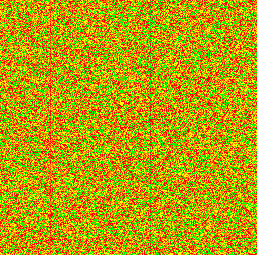In a discussion below the project review [RÖB] asked if a linear congruential generator is better that a linear feedback shift register or how are they different.
So I have tried an example for the 16-bit maximal-period Galois LFSR from Wikipedia. The result is really not bad as you can see in the pictured data (only a subtle vertical pattern can be noticed):

The Wikipedia example was slightly modified to work with seed = 0 (period of this LFSR is only 65535):
uint8_t simple_random4() { // using LFSR instead of LCG
for (uint8_t i = 0; i < 2; i++) { // we need two random bits
uint8_t lsb = ctx & 1; // Get LSB (i.e., the output bit)
ctx >>= 1; // Shift register
if (lsb || !ctx) { // output bit is 1 or ctx = 0
ctx ^= 0xB400; // apply toggle mask
}
}
return ctx & 0b00000011; // remainder after division by 4
}
Because ATtiny13 can't use MUL instruction but linear congruential generator uses a multiplication, the linear-feedback shift register is more effective and uses 22 bytes less space in flash memory (modified source and HEX file are in the download section). So maybe I can add some additional feature in the future.
 Vojtak
Vojtak
Discussions
Become a Hackaday.io Member
Create an account to leave a comment. Already have an account? Log In.